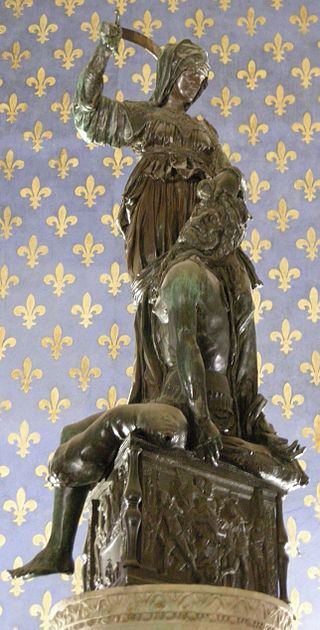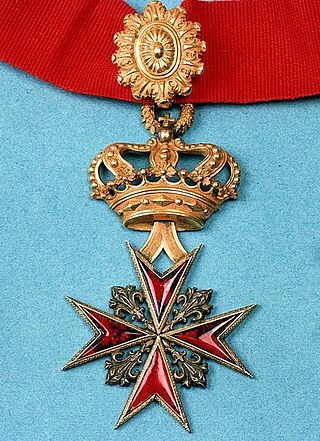
Giambologna, also known as Jean de Boulogne (French), Jehan Boulongne (Flemish) and Giovanni da Bologna (Italian), was the last significant Italian Renaissance sculptor, with a large workshop producing large and small works in bronze and marble in a late Mannerist style.

Cosimo I de' Medici was the second and last duke of Florence from 1537 until 1569, when he became the first grand duke of Tuscany, a title he held until his death. Cosimo I succeeded his cousin to the duchy. He built the Uffizi (office) to organize his administration, and conquered Siena to consolidate Florence's rule in Tuscany. He expanded the Pitti Palace and most of the Boboli Gardens were also laid out during his reign.

Livorno is a port city on the Ligurian Sea on the western coast of the Tuscany region, Italy. It is the capital of the Province of Livorno, having a population of 158,493 residents in December 2017. It is traditionally known in English as Leghorn.

The Palazzo Vecchio is the town hall of Florence, Italy. It overlooks the Piazza della Signoria, which holds a copy of Michelangelo's David statue, and the gallery of statues in the adjacent Loggia dei Lanzi.

Piazza della Signoria is a w-shaped square in front of the Palazzo Vecchio in Florence, Italy. It was named after the Palazzo della Signoria, also called Palazzo Vecchio. It is the main point of the origin and history of the Florentine Republic and still maintains its reputation as the political focus of the city. It is the meeting place of Florentines as well as the numerous tourists, located near Palazzo Vecchio and Piazza del Duomo and gateway to Uffizi Gallery.

The Loggia dei Lanzi, also called the Loggia della Signoria, is a building on a corner of the Piazza della Signoria in Florence, Italy, adjoining the Uffizi Gallery. It consists of wide arches open to the street. The arches rest on clustered pilasters with Corinthian capitals. The wide arches appealed so much to the Florentines that Michelangelo proposed that they should be continued all around the Piazza della Signoria.

Piazza dei Cavalieri is a landmark in Pisa, Italy, and the second main square of the city. This square was the political centre in medieval Pisa. After the middle of 16th century the square became the headquarters of the Order of the Knights of St. Stephen. Now it is a centre of education, being the main house of the Scuola Normale di Pisa, a higher learning institution part of the University.

Judith and Holofernes (1457–1464) is a bronze sculpture created by the Italian Renaissance sculptor Donatello towards the end of his life and career. It is located in the Hall of Lilies, in the Palazzo Vecchio, Florence, Italy. A copy stands in one of the sculpture's original positions on the Piazza della Signoria, in front of the Palazzo Vecchio.

Pierre Francqueville, generally called Pietro Francavilla, was a Franco-Flemish sculptor trained in Florence, who provided sculpture for Italian and French patrons in the elegant Late Mannerist tradition established by Giambologna.

Palazzo della Carovana is a palace in Knights' Square, Pisa, Italy, presently housing the main building of the Scuola Normale Superiore di Pisa.

The Order of Saint Stephen is a Roman Catholic Tuscan dynastic military order founded in 1561. The order was created by Cosimo I de' Medici, first Grand Duke of Tuscany. The last member of the Medici dynasty to be a leader of the order was Gian Gastone de Medici in 1737. The order was permanently abolished in 1859 by the annexation of Tuscany to the Kingdom of Sardinia. The former Kingdom of Italy and the current Italian Republic also did not recognize the order as a legal entity but tolerates it as a private body.

The Villa di Castello, near the hills bordering Florence, Tuscany, central Italy, was the country residence of Cosimo I de' Medici, Grand Duke of Tuscany (1519-1574). The gardens, filled with fountains, statuary, and a grotto, became famous throughout Europe. The villa also housed some of the great art treasures of Florence, including Sandro Botticelli's Renaissance masterpieces The Birth of Venus and Primavera. The gardens of the Villa had a profound influence upon the design of the Italian Renaissance garden and the later French formal garden.

Jacopo Inghirami was admiral of the Grand Duchy of Tuscany and marquis of Montevitozzo.

Santo Stefano dei Cavalieri is a church in central Pisa located on Piazza dei Cavalieri.

Alessandro Pieroni was an Italian architect and painter. He was active mainly in a Mannerist style, working for the courts of Grandukes Francesco I and Ferdinando I de' Medici, Grand Duke of Tuscany.

The Equestrian Monument of Ferdinando I is a bronze equestrian statue by Giambologna, executed in 1602–1607, and erected in 1608 in the Piazza of the Annunziata in Florence, region of Tuscany, Italy.

The Equestrian Monument of Cosimo I is a bronze equestrian statue executed by Giambologna from 1587 to 1594, and erected in 1594 in the Piazza della Signoria in Florence, Tuscany, Italy.

Column of Justice is an ancient Roman marble Doric column re-erected by the Florentine Medici dynasty in the Renaissance as a free-standing victory monument with a porphyry statue of Justice at the top. It stands in the Piazza Santa Trinita, in central Florence, Italy.

Belisario Vinta was an Italian statesman, knight and diplomat who served the Grand Duchy of Tuscany. Vinta held various high-ranking positions under the Medici family, particularly during the reigns of Ferdinando I and Cosimo II.























